Recent Articles
Popular Makes
Body Types
10 Most Reliable Hatchbacks
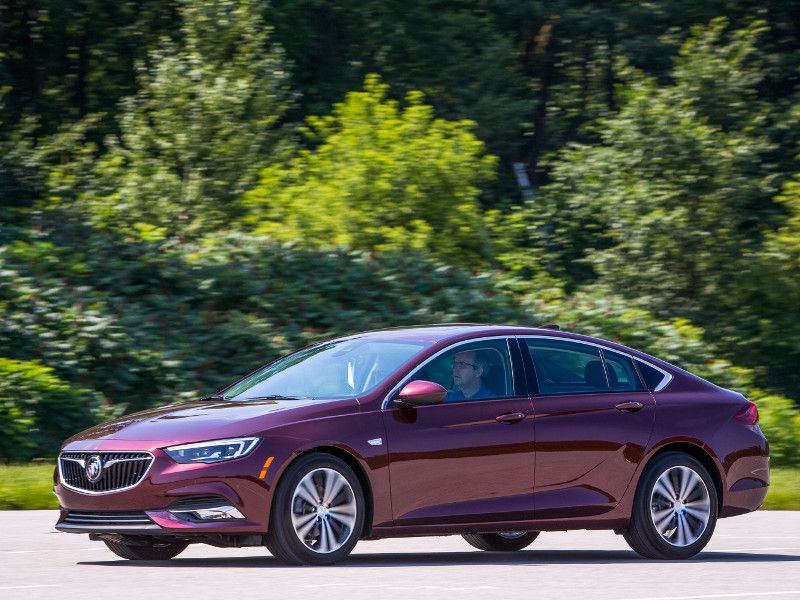
2018 Buick Regal Sportback ・ Photo by General Motors
If you’re looking for a car that maximizes both storage space and dependability, you may want to consider a vehicle from our list of the most reliable hatchbacks. They deliver the same sort of added cargo versatility as one of today’s typical SUVs, but in a smaller, more fuel-efficient package that’s often more fun to drive. Just remember, when we say “small,” we’re generally talking about subcompacts and compacts — although there are a couple of the industry’s larger new liftback sedans thrown in for good measure.
The important criteria include some sort of fifth-door opening at the rear, plus above-average predicted-reliability scores from Consumer Reports and/or a history of strong performance in the J.D. Power Vehicle Dependability Study.
2018 Toyota Yaris
Toyota is clearly the top company for reliable hatchbacks, and it all starts in the subcompact segment: Per Consumer Reports, the Yaris has segment-leading predicted-reliability scores, while J.D. Power rankings consistently show Toyota as among the highest-rated brands for long-term dependability. Of course, it’s the 2018 Yaris that’s currently reaching dealerships, but there’s no reason its dependability scores should be any different than past models.
The 2018 Yaris itself is a little different, though, since Toyota has freshened style cues and added standard content like steering-wheel-mounted audio controls and an updated standard rearview camera. Unchanged from last year is the Yaris’ comprehensive package of standard safety technologies, which a pre-collision system with automatic braking, automatic high beams, and a lane-departure alert.
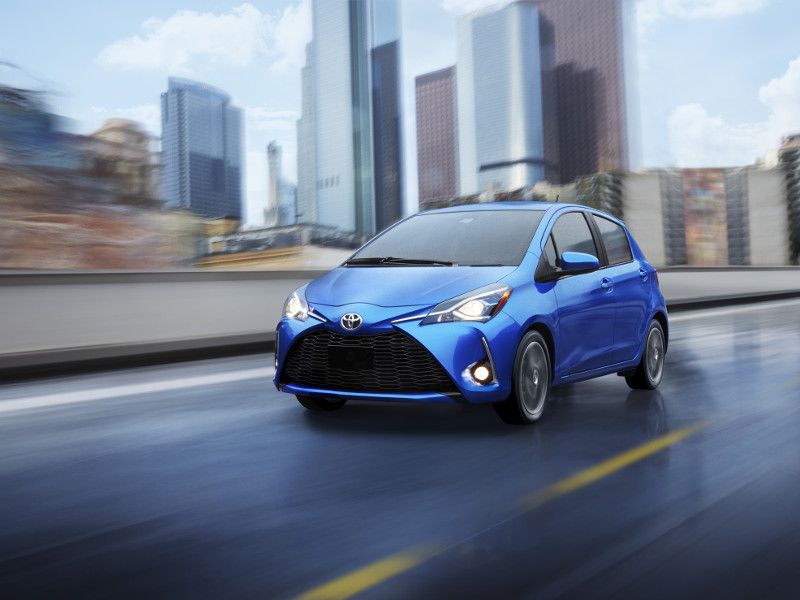
Photo by Toyota
2018 Toyota Corolla iM
Moving up to reliable hatchbacks from the compact segment, the same company competes with the 2018 Toyota Corolla iM. Again, this is a vehicle that earned the highest-possible Consumer Reports scores for predicted reliability for the 2017 model year, which is when it first joined the Toyota lineup.
The Corolla iM also matches the Yaris when it comes to standard safety content, but it wraps those benefits in a larger package with a more generous 20.8 cubic feet of storage space behind its rear seats; you can also take advantage of the car’s standard 60/40 split folding rear seats for extra interior versatility. The Corolla iM also has a larger infotainment touchscreen, measuring 7 inches diagonally.
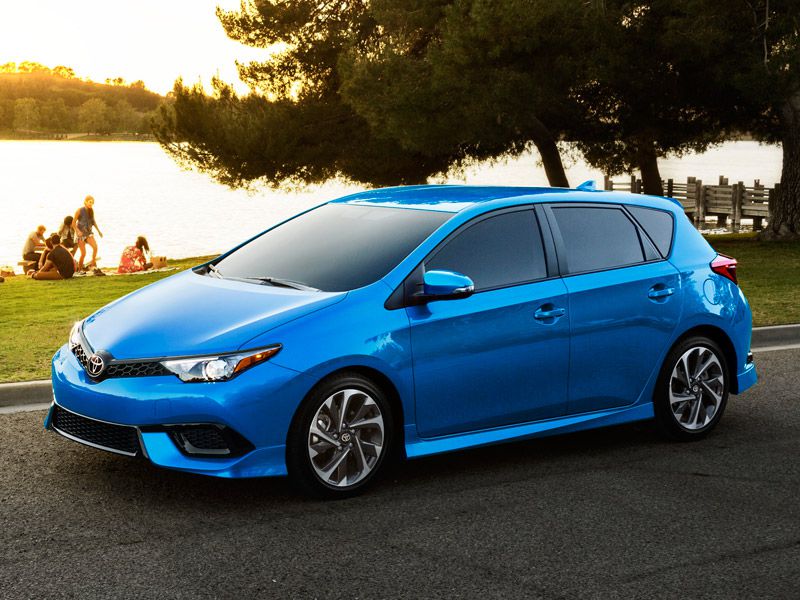
Photo by Toyota
2017 Toyota Prius
The 2017 Toyota Prius doesn’t need much of an introduction, as most folks already know it’s one of the most fuel-efficient unplugged vehicles in the country. Indeed, the gas-electric Prius now achieves EPA grades of up to 58 mpg city/53 mpg highway/56 mpg combined. And like all of Toyota’s reliable hatchbacks, the Prius builds on its green reputation with impressive ratings for predicted reliability.
Another similarity? A notable focus on standard safety technology, backed by driver-assistance measures such as a rearview camera, adaptive cruise control, lane-departure alert with steering assistance, automatic high beams and the Toyota pre-collision system. Further standard tech highlights are a 6.1-inch infotainment touchscreen, Bluetooth connectivity and voice recognition.
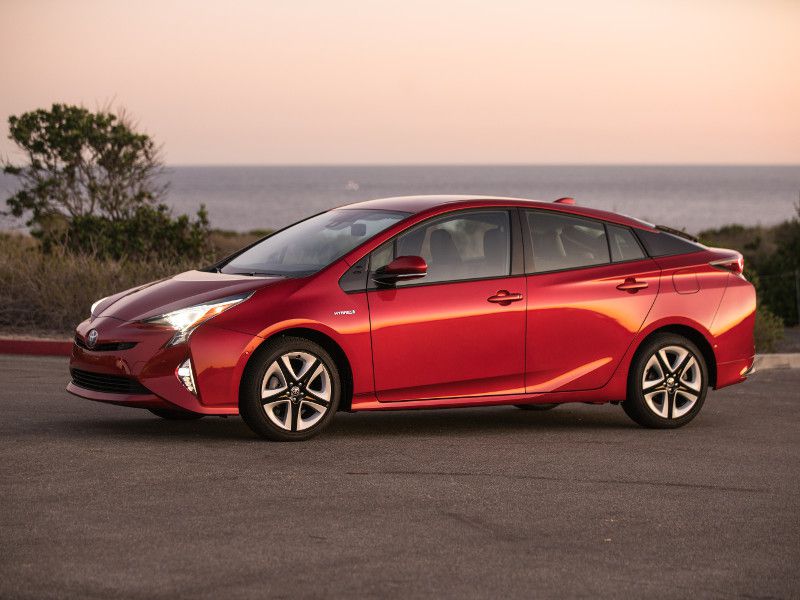
Photo by Toyota
2017 Toyota Prius v
The last of the best-rated reliable hatchbacks from Toyota is the biggest player on the Prius roster. True, it’s only a few inches longer than the “regular” Prius, but the Prius v’s more cargo-friendly design can handle a whopping 34.3 cubic feet of gear in the back even with the rear seats in use. Drivers who need more space can fold down the rear seat in a 60/40 split to hold more cargo than some SUVs.
The Prius v also meets the needs of customers who demand higher fuel-economy ratings, thanks to EPA grades of 43 mpg city/39 mpg highway/41 mpg combined. Based on EPA data for gas prices and annual driving distances, Prius v drivers can save $2,750 in five-year fuel costs versus drivers of the average new vehicle.
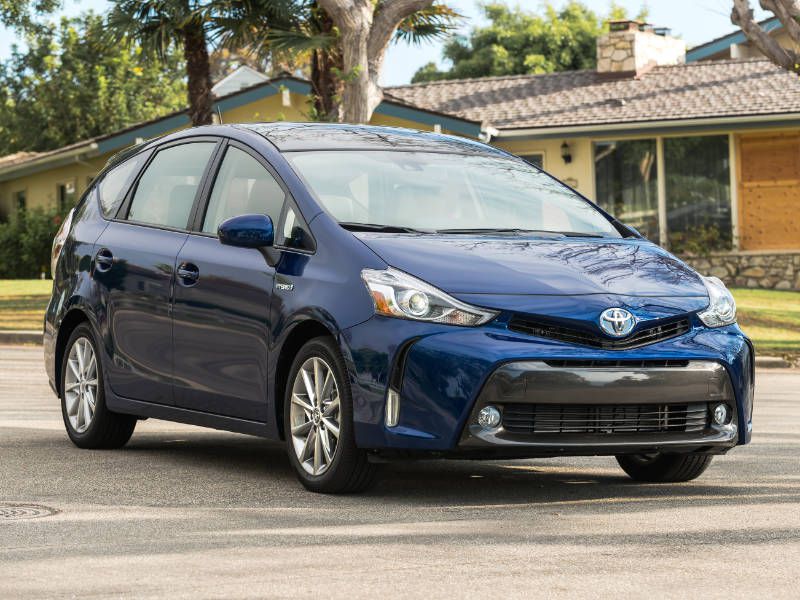
2018 Buick Regal Sportback
Buick is a brand that’s well known for high vehicle dependability scores, but probably less well recognized for its five-door cars. However, that could change with the debut of the all-new 2018 Regal Sportback. The car does still offer the kind of predicted-reliability rating we prefer in reliable hatchbacks, but as its name suggests, the Regal Sportback has the same liftback body style as premium German entries like the Audi A7.
Instead of a traditional trunk, the Sportback features a roof-hinged back hatch for a standard cargo capacity of 31.5 cubic feet and the ability to carry 60.7 cubic feet of cargo with the rear seats folded. Owners also enjoy a standard Wi-Fi hotspot and Android Auto/Apple CarPlay smartphone integration.

Photo by General Motors
2018 Audi A7
About that just-mentioned Audi: Despite slightly lower predicted-reliability levels than the Buick Regal Sportback and noticeably less cargo space, the 2018 A7 is certainly the more luxurious and powerful of these premium liftbacks. It’s also more expensive, with an MSRP of $69,700.
Of course, that price covers luxury cues such as eight-way power-adjustable and heated leather seats, leather seating surfaces, real birch-wood cabin accents, LED exterior lights, a hands-free power liftgate, four-zone automatic climate control, and a navigation-based infotainment system with a mobile Wi-Fi hotspot and Android Auto/Apple CarPlay. And standard beneath the A7’s sleek hood is a supercharged 340-horsepower engine that helps this full-size sport sedan race from 0-60 in 5.2 seconds.

2018 Chevrolet Cruze
There’s a fairly wide range of reliable hatchbacks available in the compact segment, and that includes the 2018 Chevrolet Cruze. But the Cruze also provides much more than robust reliability grades. Additional selling points for the car are its high-tech connectivity resources, high levels of safety content and an optional high-efficiency power plant.
More specifically, the Cruze supplies a mobile Wi-Fi hotspot and Android Auto/Apple CarPlay smartphone integration, driver-assistance measures from a forward-collision warning to rear cross-traffic alert, and a thrifty turbodiesel engine. It’s a 1.6-liter, four-cylinder unit that makes 137 horsepower and 240 lb-ft of torque, which represents an extra 63 lb-ft more than in a gasoline-powered Cruze. For the Cruze hatchback, that engine then delivers EPA ratings of up to 29 mpg city, 48 mpg highway and 35 mpg overall.
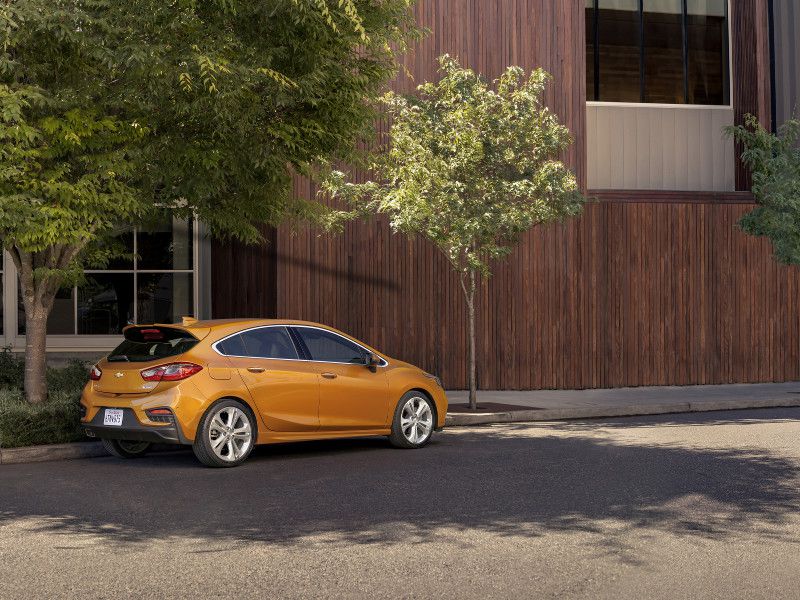
Photo by Toyota
2018 Mazda Mazda3
The 2018 Mazda3 can’t quite match the very highest predicted-dependability scores found in some reliable hatchbacks, yet it’s still a cut above the average compact entries — and not just in terms of dependability, either. It also comes with the Mazda brand’s zoomy driving dynamics as well as the company’s i-ACTIVSENSE bundle of safety features.
Backed by that package and more, drivers can depend on the Mazda3 for automatic emergency braking, a blind-spot monitor, adaptive cruise control, adaptive headlights and lane-keeping assistance. Furthermore, with 47.1 cubic feet of total cargo space, the Mazda3 has a larger overall cargo capacity than the Honda Civic hatch.
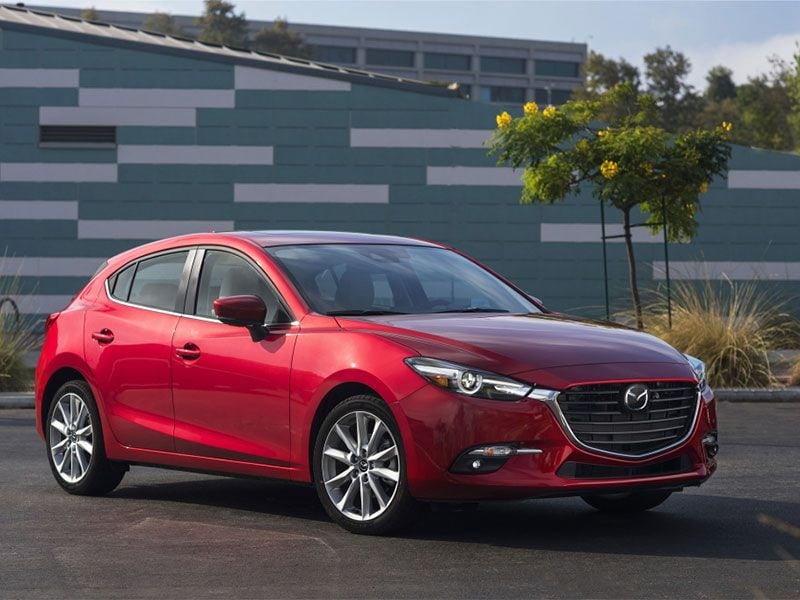
Photo by Mazda
2018 Subaru Impreza
If you like reliable hatchbacks like the Mazda3, you’ll probably also appreciate 2018 Subaru Impreza. After all, the Impreza has the same Consumer Reports predicted-reliability score as the Mazda, along with its own specially branded package of driver-assistance measures. The EyeSight setup for the Impreza includes adaptive cruise control, automatic pre-collision braking and lane-departure/sway warning, and also available are a blind-spot monitor, lane-keeping assistance, rear cross-traffic alert and adaptive headlights.
The difference-makers for the Impreza are its standard symmetrical all-wheel-drive system, standard Android Auto/Apple CarPlay smartphone-integration technologies, and an even larger rear storage capacity; here, folding the back seats allows owners to manage up to 55.3 cubic feet of cargo.
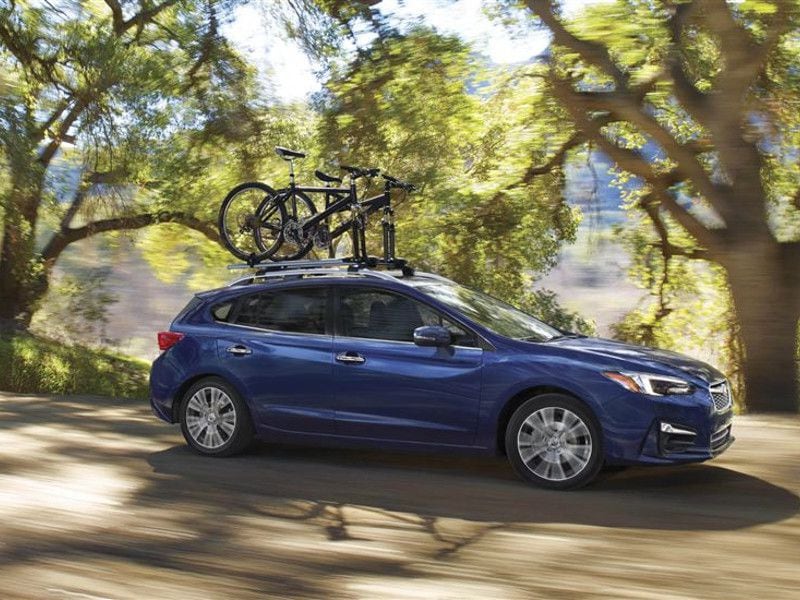
Photo by Subaru
2018 Hyundai Elantra GT
The 2018 Hyundai Elantra GT may share a name with the brand’s mainstream compact sedan, but it’s obvious that these are fraternal twins, not identical. The GT is by far the sportier-looking of the two, with a sizzling hot-hatch design, which it backs up with an available turbocharged engine rated at 195 horsepower and 201 lb-ft of torque.
The Elantra GT also checks in with standard Android Auto/Apple CarPlay smartphone integration and a comprehensive array of optional safety systems. Predicted reliability nor cargo hauling are further strong points. This compact Hyundai hatch provides 24.9 cubic feet of space behind its rear seats and 55.1 cubic feet in total.
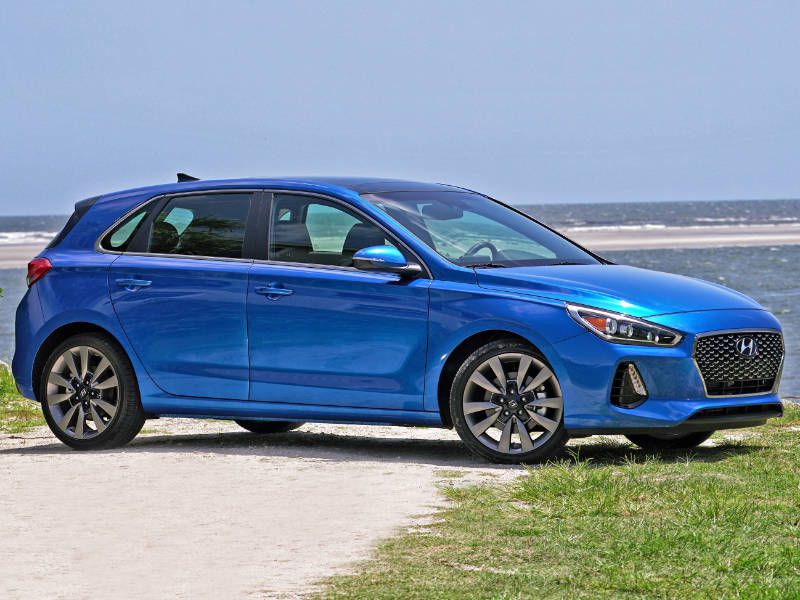
Photo by Hyundai